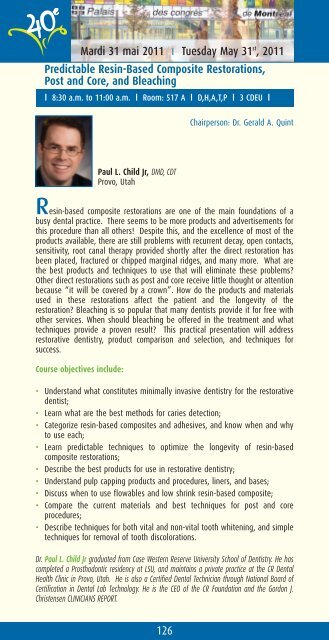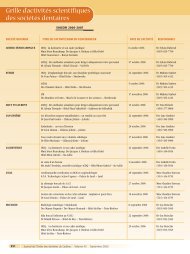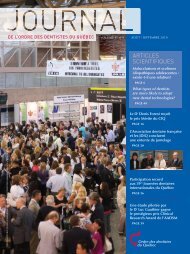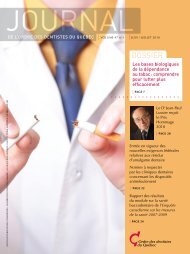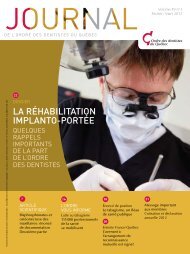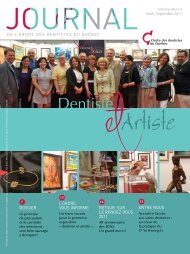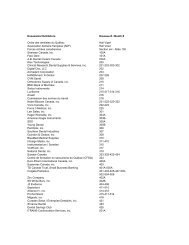Programme scientifique - Ordre des dentistes du Québec
Programme scientifique - Ordre des dentistes du Québec
Programme scientifique - Ordre des dentistes du Québec
Create successful ePaper yourself
Turn your PDF publications into a flip-book with our unique Google optimized e-Paper software.
Mardi 31 mai 2011 I Tuesday May 31 st , 2011<br />
Predictable Resin-Based Composite Restorations,<br />
Post and Core, and Bleaching<br />
I 8:30 a.m. to 11:00 a.m. I Room: 517 A I D,H,A,T,P I 3 CDEU I<br />
Paul L. Child Jr, DMD, CDT<br />
Provo, Utah<br />
126<br />
Chairperson: Dr. Gerald A. Quint<br />
Resin-based composite restorations are one of the main foundations of a<br />
busy dental practice. There seems to be more pro<strong>du</strong>cts and advertisements for<br />
this proce<strong>du</strong>re than all others! Despite this, and the excellence of most of the<br />
pro<strong>du</strong>cts available, there are still problems with recurrent decay, open contacts,<br />
sensitivity, root canal therapy provided shortly after the direct restoration has<br />
been placed, fractured or chipped marginal ridges, and many more. What are<br />
the best pro<strong>du</strong>cts and techniques to use that will eliminate these problems?<br />
Other direct restorations such as post and core receive little thought or attention<br />
because “it will be covered by a crown”. How do the pro<strong>du</strong>cts and materials<br />
used in these restorations affect the patient and the longevity of the<br />
restoration? Bleaching is so popular that many dentists provide it for free with<br />
other services. When should bleaching be offered in the treatment and what<br />
techniques provide a proven result? This practical presentation will address<br />
restorative dentistry, pro<strong>du</strong>ct comparison and selection, and techniques for<br />
success.<br />
Course objectives include:<br />
• Understand what constitutes minimally invasive dentistry for the restorative<br />
dentist;<br />
• Learn what are the best methods for caries detection;<br />
• Categorize resin-based composites and adhesives, and know when and why<br />
to use each;<br />
• Learn predictable techniques to optimize the longevity of resin-based<br />
composite restorations;<br />
• Describe the best pro<strong>du</strong>cts for use in restorative dentistry;<br />
• Understand pulp capping pro<strong>du</strong>cts and proce<strong>du</strong>res, liners, and bases;<br />
• Discuss when to use flowables and low shrink resin-based composite;<br />
• Compare the current materials and best techniques for post and core<br />
proce<strong>du</strong>res;<br />
• Describe techniques for both vital and non-vital tooth whitening, and simple<br />
techniques for removal of tooth discolorations.<br />
Dr. Paul L. Child Jr gra<strong>du</strong>ated from Case Western Reserve University School of Dentistry. He has<br />
completed a Prosthodontic residency at LSU, and maintains a private practice at the CR Dental<br />
Health Clinic in Provo, Utah. He is also a Certified Dental Technician through National Board of<br />
Certification in Dental Lab Technology. He is the CEO of the CR Foundation and the Gordon J.<br />
Christensen CLINICIANS REPORT.


